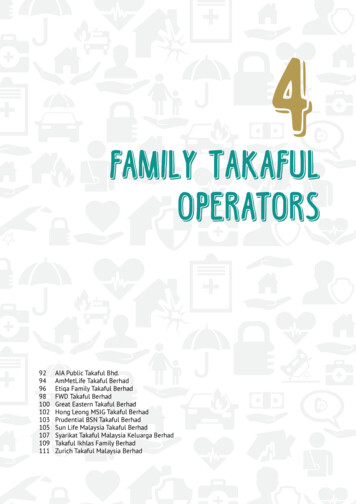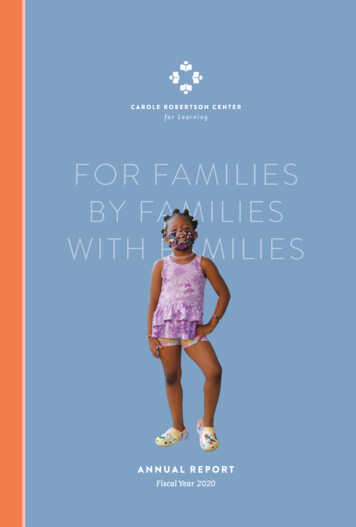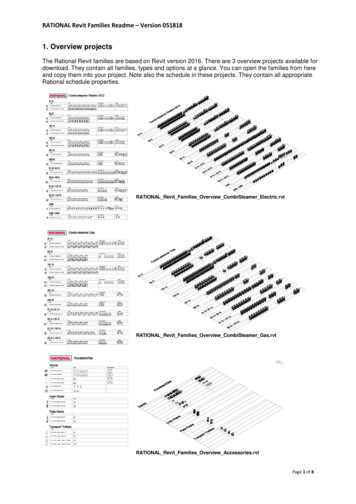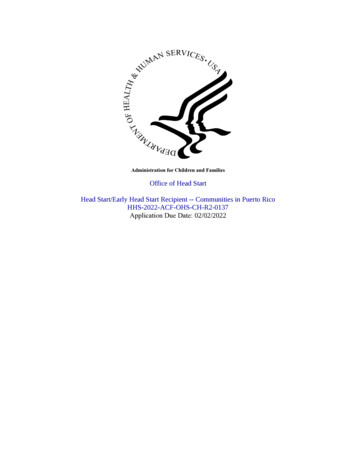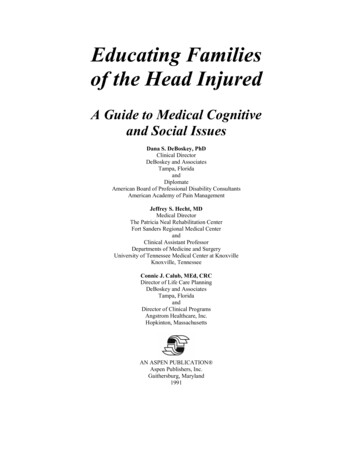
Transcription
Educating Familiesof the Head InjuredA Guide to Medical Cognitiveand Social IssuesDana S. DeBoskey, PhDClinical DirectorDeBoskey and AssociatesTampa, FloridaandDiplomateAmerican Board of Professional Disability ConsultantsAmerican Academy of Pain ManagementJeffrey S. Hecht, MDMedical DirectorThe Patricia Neal Rehabilitation CenterFort Sanders Regional Medical CenterandClinical Assistant ProfessorDepartments of Medicine and SurgeryUniversity of Tennessee Medical Center at KnoxvilleKnoxville, TennesseeConnie J. Calub, MEd, CRCDirector of Life Care PlanningDeBoskey and AssociatesTampa, FloridaandDirector of Clinical ProgramsAngstrom Healthcare, Inc.Hopkinton, MassachusettsAN ASPEN PUBLICATION Aspen Publishers, Inc.Gaithersburg, Maryland1991
2Library of Congress Cataloging-in-Publication DataDeBoskey, Dana S.Educating families of the head injured: a guide to medical, cognitive, and social issues /Dana S. DeBoskey, Jeffrey S. Hecht, Connie J. Calub.p. cm.Includes bibliographical references and indexISBN: 0-8342-Q231-X1. Brain damage Patients Rehabilitation. 2. Brain damage Patients Family relationships.3. Brain damage Patients Home care. I. Hecht, Jeffrey S. II. Calub, Connie J. III. Title.[DNLM: 1. Brain Injuries psychology. 2. Brain Injuries rehabilitation. 3. Family. 4. PatientEducation. WL 354 D287e]RC387.5.D43 1991617.4'8103 dc20DNLM/DLCfor Library of Congress91-17206CIPCopyright 1991 by Aspen Publishers, Inc.All rights reserved.Aspen Publishers, Inc., grants permission for photocopying for limited personal or internal use. This consent doesnot extend to other kinds of copying, such as copying for general distribution, for advertising or promotionalpurposes, for creating new collective works, or for resale. For information, address Aspen Publishers, Inc.,Permissions Department, 200 Orchard Ridge Drive,Gaithersburg, Maryland 20878.The authors have made every effort to ensure the accuracy of the information herein, particularly with regard to drugselection and dose. However, appropriate information sources should be consulted, especially for new or unfamiliardrugs or procedures. It is the responsibility of every practitioner to evaluate the appropriateness of a particular opinionin the context of actual clinical situations and with due consideration to new developments. Authors, editors, and thepublisher cannot be held responsible for any typographical or other errors found in this book.Editorial Services: Lorna PerkinsLisa HajjarLibrary of Congress Catalog Card Number: 91-17206ISBN: 0-8342-0231-XPrinted in the United States of America12345
3Table of ContentsPreface. 8Introduction: How To Use This Guide. 9Medical Issues. 13TRAUMA SCENE: A CASE SCENARIO . 13IN THE EMERGENCY ROOM. 14IN THE INTENSIVE CARE UNIT . 18COMA. 29SPECIAL MEDICAL PROBLEMS IN THE ACUTE SETTING . 32NORMAL BRAIN FUNCTION. 33NATURE OF BRAIN INJURY. 38TYPES OF FOCAL DEFICITS. 43PROGNOSIS . 47INCIDENCE AND PREVENTION OF BRAIN INJURY . 52Inpatient Rehabilitation . 55MEDICAL FOCUS . 55THERAPEUTIC FOCUS . 58INTERDISCIPLINARY TEAM APPROACH . 63BEHAVIORAL ISSUES INVOLVING THE PATIENT . 65BEHAVIORAL ISSUES INVOLVING THE FAMILY. 70Preparing for Home. 78DISCHARGE/RETURN TO THE HOME. 78MEDICAL ISSUES . 79PRACTICAL ISSUES FOR THE FAMILY . 81Outpatient Options . 95TYPES OF FACILITIES. 95TYPES OF TREATMENTS. 98Mild-to-Moderate Head Trauma. 104MILD VERSUS MODERATE. 104INCIDENCE . 104RESIDUAL EFFECTS . 104DOCUMENTATION . 105COMPOUNDING FACTORS. 105TREATMENT OPTIONS . 106Funding Sources. 109INSURANCE. 109STATE VOCATIONAL REHABILITATION . 110WORKERS' COMPENSATION . 111PUBLIC ASSISTANCE . 111CHILDREN'S MEDICAL SERVICE . 111FUNDING THROUGH LITIGATION . 112MEDICAID. 112MEDICARE. 113How To Choose an Appropriate Treatment Facility. 115REVIEW OF CHOICES. 115LIFETIME COSTS. 119
4Long-Term Placement Considerations . 121RESIDENTIAL HEAD TRAUMA PROGRAM . 121EXTENDED CARE LIVING FACILITY. 122HOME. 122Cognitive Problems and How To Manage Them . 125MEMORY DIFFICULTIES . 125PERCEPTUAL PROBLEMS . 126ATTENTION/CONCENTRATION PROBLEMS. 127LACK OF INITIATIVE . 128COMPREHENSION/UNDERSTANDING DIFFICULTIES. 129EXPRESSIVE DIFFICULTIES . 130SEQUENCING PROBLEMS. 132SLOWED RESPONSES. 133INFLEXIBILITY. 133DISORGANIZATION. 135PROBLEM-SOLVING DIFFICULTIES . 136NEW-LEARNING PROBLEMS. 137Behavioral Problems and How To Manage Them. 139AGITATION. 140DENIAL/OVEROPTIMISM . 142IMPATIENCE . 143IRRITABILITY . 144OUTBURSTS . 145PERSEVERATION . 146FAMILY ABUSE . 148EGOCENTRISM . 149OVERDEPENDENCY . 150LABILITY . 151SUSPICIOUSNESS. 152DEPRESSION . 153LACK OF MOTIVATION/INITIATIVE. 155INAPPROPRIATE SOCIAL BEHAVIOR . 156INCREASED SEXUAL FOCUS . 157EXCESSIVE TALKING . 158LOSS OF CONTROL. 159Emotional Problems Experienced by Families. 161SHOCK . 161ANXIETY. 162DENIAL/OVEROPTIMISM . 163ANGER. 165FATIGUE . 165IRRITABILITY/IMPATIENCE. 166FRUSTRATION . 166FEELINGS OF HOPELESSNESS/HELPLESSNESS. 167GUILT/AMBIVALENCE . 168FAMILY DISUNITY . 169
5DECREASED SOCIAL CONTACT/LEISURE TIME . 170LOSS OF LOVE . 170ROLE CHANGES . 171Long-Term Medical Problems. 174POSTTRAUMATIC EPILEPSY. 174ALCOHOL AND DRUG ABUSE AND THE RISK OF REPEAT HEADINJURIES . 175LATE HYDROCEPHALUS . 175DEEP VEIN THROMBOSIS AND VENOUS INSUFFICIENCY . 176UNPLANNED PREGNANCY/VENEREAL DISEASE . 176ACNE VULGARIS . 176TEMPOROMANDIBULAR JOINT DYSFUNCTION . 176DIPLOPIA (Double Vision) . 177OBESITY AND OVEREATING . 177PSYCHOSIS AND SEVERE LOSS OF CONTROL . 177Long-Term Psychosocial Problems . 179SENSE OF BEING DIFFERENT . 180STRAINED FAMILY RELATIONSHIPS. 181LOSS OF FRIENDS . 182DIFFICULTY RETURNING TO WORK OR SCHOOL . 184LOSS OF JOB OR CAREER . 185INACTIVITY . 187Substance Use/Abuse and the TBI Survivor . 189INCIDENCE . 189TREATMENT CONSIDERATIONS. 189Medications and Side Effects . 194The Family as Educator . 204ATTORNEYS. 204TEACHERS. 204EMPLOYERS. 205PHYSICIANS . 205INSURANCE COMPANIES. 205Special Considerations for Children . 208NEUROANATOMY . 208REHABILITATION ISSUES. 208PROGNOSIS . 210SEIZURES. 211OTHER MEDICAL ISSUES. 211EPIDEMIOLOGY . 211Special Considerations for the Elderly . 215EFFECTS OF AGE. 215MEDICATIONS . 216PROGNOSIS . 217PREVIOUS HEAD INJURY. 218Community Reintegration. 220BACK TO SCHOOL . 220
6BACK TO WORK. 223COMMUNITY RESOURCES . 227
7With contributions byHolli Bodner, PsyDStaff PsychologistMediplex Rehab-BradentonBradenton, FloridaandPsychological Private PracticeSarasota, FloridaDeborah Kurtz, MS, CCC-SLPStroke-Neuro Program DirectorRehabilitation Institute of SarasotaSarasota, Florida
8PrefaceTo the health care professional:This book, while written for families of the head injured, is specificallydesigned to assist you, the professional. It is comprehensive as well as practicalin describing and resolving problems. The loose-leaf format allows you tocustomize the application to each case. Some families may want to read all ofthe chapters. In other cases, you will need to review certain sections withfamily members. Whatever procedure you follow, Educating Families of theHead Injured presents you with an excellent opportunity to educate familiesproperly and to ensure that those families become effective members of therecovery team.Chapter 1Introduction: How To Use This GuideTo the health care professional:Some families may want to read the entire book; however, this could beoverwhelming and much of what they read would be forgotten. In many cases, itwill be more appropriate for you to direct them to the chapters that will be ofgreatest significance to them.
9Chapter 1Introduction: How To Use This GuideYou, the family or primary caretaker, are often the key to the success of your loved one'srehabilitation after head injury. This may seem like an awesome responsibility. In fact, it is.Nevertheless, all research studies, as well as general clinical observations, point to the fact thatyou are a key player in the treatment team. Why so? Why can't you just leave your loved one'streatment to the hands of those who have been professionally trained and have a wealth ofexperience handling these issues on a day-to-day basis? Why can't you just have them tell youwhen he will be ready (fixed) so that you can come back to get himYou could do this leave it to the professionals but it would not be to the best advantage ofeither you or your loved one. First, your immediate involvement helps you to feel that you are apart of what is going on, and it gives you an opportunity to talk with the therapists who will be avery important part of your loved one's life. Also, once your family member is conscious (ormaybe even before), your presence reassures him that these people have his best interest at heartor you would not be there allowing them to participate in his rehabilitation. Moreover, familypresence provides a sense of security that allows the individual to maintain his motivation andunderstand that he must work hard to get better.Just because the family can be so vital to your loved one's recovery does not mean that weexpect the family to do everything. And it does not mean that if rehabilitation efforts over theyears meet failure, it is your fault. In some instances, a family will give their all (and maybe toomuch) with a less than optimum outcome. And in others, a patient will do fairly well in spite oflittle family support. Nevertheless, the fact remains that an important part of the burden for yourloved one's rehabilitation falls on you.We note that there are times when the primary caretaker is not family by blood or marriage.Sometimes it will be a person who is described as like family or better than family, such as alifelong close friend. At other times the term family may apply to the staff at an extended-carefacility, transitional living facility, or some other type of long-term caretaker arrangement.Now, here are a few words regarding how to use this book. We could have continued to refineand elaborate the information in this book to the point where it covered just about everything indetail. However, that might mean that families would find it unwieldy to use or that it would notbe used at all. Rather, we felt it was important to get the wealth of information contained in thebook to families of the head injured in the clearest and most useful format possible. The loose-leafformat was used so that those of you who need only a few selected sections can obtain them fromyour rehabilitation facility. However, you still have the option to purchase the entire book if youdesire to obtain all of the information provided on all areas of head injury rehabilitation. While
10your loved one is in intensive care, for example, it is sometimes easier to readjust those sections ofthe book that pertain to the immediate future, rather than worry about what the recovery statusmay be 2 years after the injury. Worrying about vocational retraining while he is in intensive careis probably not the best use of your energy at that time. This is not necessarily the type of bookthat you sit down and read cover to cover, although that is one option. To provide the informationthat is most pertinent for you at specific points in time, let us pose some typical situations, alongwith the chapters that are important for these situations: Your loved one was recently injured.Read Chapter 2 thoroughly.Skim Chapters 3, 8, and 9.Skim Chapter 18 if a child is injured.Skim Chapter 19 if an older adult is injured.Your loved one is in a coma.Read Chapter 2.Paying for rehabilitation services is an issue.Read Chapter 7.You are trying to choose the most appropriate treatment program.Read Chapters 5 and 8.Contact the National Head Injury Foundation.Your loved one stayed in the hospital less than 24 hours.Read Chapter 6.The doctor said your loved one had no brain damage but he seems different to you.Read Chapter 6.Skim Chapters 10 and 11.Your loved one is ready to go home are you ready for him?Read Chapters 4, 5, 10, 11, and 12.You are concerned about legal issues.Read Chapter 7.Read Chapter 8.Your loved one is not the person he used to be.Read Chapters 10, 11, and 14.You are not the person you used to be.Read Chapter 12.Contact a counselor who knows about head injury.You are concerned about and/or do not understand all the medications.Read Chapter 16.You are concerned that your loved one's previous drug or alcohol problem may be an issue.Read Chapter 15.You are having trouble getting your medical questions answered by someone who knowslong-term head injury issues.Read Chapter 13.Read Chapter 14 if a child is involved.Read Chapter 19 if an older adult is involved.It seems that you need to play an expert role.Read Chapter 17.
11 How do we get him back out into the community?Read Chapter 20.Your home needs a rest from having to care for your loved one 24 hours every day.Read Chapter 9.Someone in your family thinks your loved one is spoiled and could act better if he wanted.Mark the pertinent behaviors in Chapters 10 and 11 and ask that family member to readthose sections maybe he will get interested and read more.You will find that, as you progress through the different stages of your development andawareness of head injury rehabilitation, the information in each chapter will take on new meaning.This is particularly true if you are involved with a recently injured individual. Try to rememberthat it may be helpful to go back and reread various sections at a later date.Throughout this book, we have attempted to present the information in as clear and as easy-tounderstand manner as possible. However, you will note that many medical terms are used,particularly in the medically oriented chapters. When at all possible, we have briefly explainedwhat these terms mean. We think it is important for you to be exposed to these words and theirmeanings. A list of many of the terms is included in the back of the book. As you read along, youcan skim the medical terms and just read the descriptions provided.Although we are quite aware that not all head-injured individuals are male, the male gender isused for the sake of simplicity. We hope that this will not be offensive to any of our readers. Last,we welcome suggestions from our readers. Please send your specific recommendations regardingreadability, usefulness, and the possible need for additional information to:Dana S. DeBoskeyJeffrey S. HechtConnie J. CalubDeBoskey and Associates2807 W. Busch BoulevardTampa, Florida 33618
12Chapter 2Medical IssuesTo the health care professional:This chapter focuses on the many medical issues involved in TBI from the traumascene, to the emergency room, to intensive care. Although written for the layman, alarge number of medical terms are introduced. You may want to present certainsections to family members at appropriate times.
13Chapter 2Medical IssuesTRAUMA SCENE: A CASE SCENARIOHe had one for the road before stepping into his black sports car that holiday weekend. Henever liked to wear a seatbelt too confining.Lights flashed and sirens screamed as the emergency medical team (EMT) raced toward thescene. They found him with the remains of a new black sports car wrapped around him like ahideous coffin. Was he alive and breathing? Yes, although his pulse was weak from so muchblood loss.Carefully, they stabilized his spine on a board, splinted the open bone fractures, and lifted himinto the ambulance. They quickly started intravenous (IV) lines pumping fluid into him. Oxygenwas given by mask. Fortunately, cardiopulmonary resuscitation (CPR) was not needed in thiscase.He was met at the hospital by the trauma surgeon who would coordinate the efforts of a teamof physicians and paraprofessionals. His clothes were cut from his body in the emergency room.Blood was drawn to check his blood count, to cross match his blood for transfusion, to determinethe ratio of important chemicals in his blood, and to check the level of alcohol or other drugs.Larger IV lines were started and fluids poured in. Arterial blood was drawn to check how well hewas getting oxygen. A central venous pressure (CVP) line was placed to check that he was gettingenough fluid. This was later switched for a Swan-Ganz tube to give more detailed measurements.Another tube was placed into his bladder and left connected to a bag to measure urine output. Atube was placed through the mouth into his breathing tube to better carry air to his lungs andoxygenate his blood. Electrocardiographic (EKG) leads were placed on his chest to monitor hisheart rhythm. A tube was placed through his nose into his stomach and started on suction to drainhis stomach contents and prevent vomiting. An arterial blood line was started to follow his oxygenstatus continuously. Emergency X-rays revealed a collapsed lung. The emergency room (ER)physician inserted a chest tube and connected it to a draining device to reexpand the lung. Astomach tap was performed to determine whether there was internal hemorrhaging (bleeding). Thesurgeon entered the abdomen by a small incision (surgical cut) near the umbilicus (belly button).Fluid was run into the belly, removed, and examined for the abnormal presence of blood.Fortunately, the general surgeon agreed that no abdominal surgery was needed, as little blood wasfound. He was also evaluated by the neurosurgeon, the orthopedic surgeon, and the oral surgeon.
14Stabilized, he was rushed into radiology for X-rays of the skull, pelvis, and several long bones.He had an intravenous pyelogram (IVP) or kidney and bladder X-ray to rule out any injury tothese vital organs. He underwent a computerized axial tomography (CT or CAT) scan of the headand brain. Because of large right-sided hematomas (bleeding), he underwent emergency brainsurgery to remove the hematomas before further damage could be done by the blood pressing thebrain within the narrow confines of the skull. He underwent a craniotomy (opening of the skull)and craniectomy (removal of part of the skull). He also underwent placement of a tube from thefluid filled cavities within the brain to an outside monitoring device so that intracranial pressure(ICP) in the brain could be monitored. After the brain surgery, his fractured jaw was wired by theoral surgeon. His thigh bone was placed in traction by the orthopedic surgeon. In this case,corrective surgery would be completed several days later. Stable after surgery, he was transferredto the intensive care unit (ICU).In the ICU, under the care of the trauma surgeon, the various tubes were connected tosophisticated monitoring machines. Nurses recorded his various vi
American Academy of Pain Management Jeffrey S. Hecht, MD Medical Director The Patricia Neal Rehabilitation Center Fort Sanders Regional Medical Center and Clinical Assistant Professor Departments of Medicine and Surgery University of Tennessee Medical Center at Knoxville Knoxville, Tennessee Connie J. Calub, MEd, CRC Director of Life Care Planning






